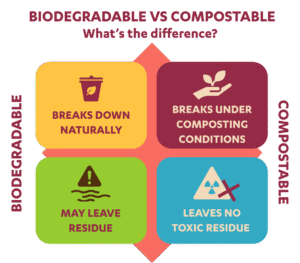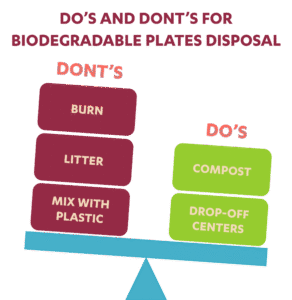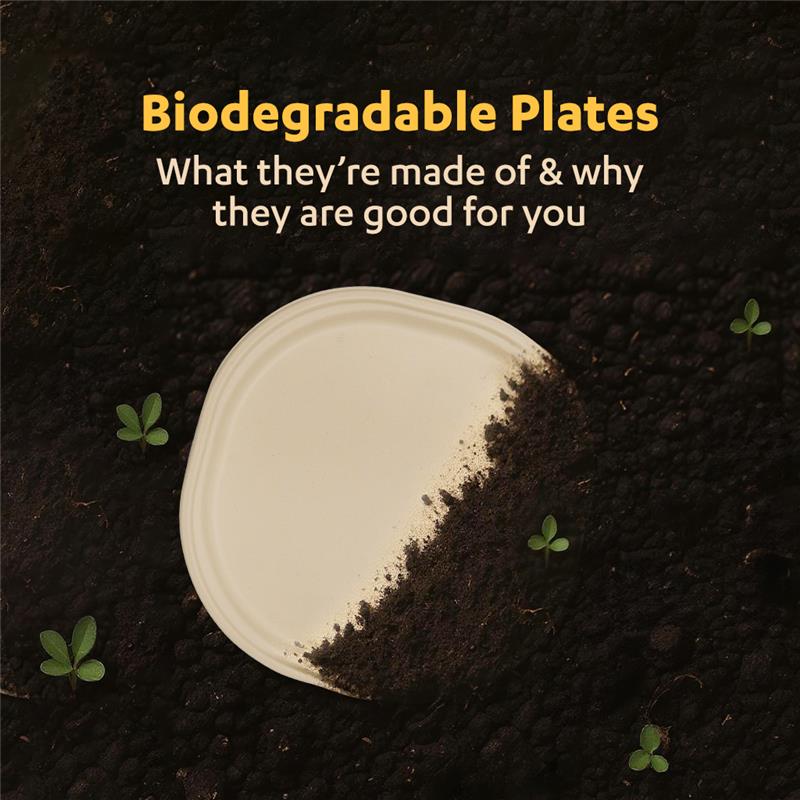From food stalls to big fat Indian weddings, a disposable plate plays a starring role in how we serve and share food. Now, there’s a better way to do it — one that’s kind to the earth and still gets the job done beautifully.
Biodegradable plates are made from natural materials that return to the soil after use. Whether it’s sugarcane plates, bamboo plates disposable, or other types of eco friendly disposable plates, these options combine convenience with care for the planet.
As more people turn to compostable dinnerware and eco-friendly tableware, it’s clear that the future of mealtime is both sustainable and stylish. In this blog, we explore what compostable plates are made of, how they’re used, and why they matter more than ever today.
What Are Biodegradable Plates?
Biodegradable plates are single-use plates made from natural materials that break down safely in the environment. Unlike plastic or foam, which can take hundreds of years to decompose, these plates return to the earth — often within months.
They’re designed for easy use and easy disposal. When composted properly, they turn into nutrient-rich soil, making them a smart choice for those who want to reduce their environmental footprint without giving up on convenience.
From sugarcane plates to bamboo plates, biodegradable options now come in many forms.
In short, biodegradable plates are the planet-friendly alternative to conventional tableware — perfect for everything from food deliveries to festive gatherings.
Biodegradable vs Compostable: What’s the Difference?
Need a side-by-side comparison sheet here for compostable & biodegradable
Biodegradable: Breaks down naturally, may leave residue.
Compostable: Breaks down under composting conditions, leaves no toxic residue.

The terms biodegradable and compostable are often used interchangeably, but there’s a big difference.
- Biodegradable plates break down naturally with the help of microbes. However, the time they take and what they leave behind can vary.
- Compostable plates, on the other hand, decompose under specific composting conditions and leave behind no toxic residue, just nutrient-rich compost.
In simpler terms, compostable dinnerware is always biodegradable, but not all biodegradable items are truly compostable. When in doubt, look for certified compostable plates that are tested for safe, complete breakdown.
Why Plastic & Foam Disposables Are Not Good for You?
Plastic and foam plates may be cheap and widely available, but they come with a heavy environmental cost.
They don’t break down for centuries and often end up polluting land, rivers, and oceans. Burning them releases harmful toxins, and recycling isn’t always possible due to contamination.
In contrast, eco-friendly disposable plates made from materials like sugarcane, bamboo, or areca leaves offer a cleaner, safer, and more sustainable option — for people and the planet.
Choosing eco-friendly tableware is more than a trend; it’s a responsibility. Every meal served on a biodegradable plate is a small step toward a cleaner future.
What Are Biodegradable Plates Made From?
Biodegradable plates come from nature — quite literally. Instead of fossil fuels and chemicals, they’re crafted from agricultural byproducts and plant-based fibers that are safe for the earth.
Each material brings its own strengths — from sturdiness and aesthetics to how quickly it composts. Let’s explore the most common materials used to make eco friendly disposable plates:
Sugarcane Plates (Bagasse)
Made from the fibrous residue left after extracting juice from sugarcane, sugarcane plates (also called bagasse plates) are strong, heat-resistant, and fully compostable. They’re widely used in food delivery and catering due to their sturdiness and smooth finish.
Bamboo Plates Disposable
Bamboo plates disposable are elegant, lightweight, and naturally antibacterial. Bamboo is a fast-growing, renewable resource, making these plates a great option for premium dining experiences, weddings, and upscale events.
Areca Leaf Plates
Crafted by pressing fallen areca palm leaves, these plates are rustic, sturdy, and fully biodegradable. But these are only found in certain geographical regions which might increase the carbon footprint of carrying these plates from one location to other.
Uncoated paper plates (without any plastic or wax lining) are simple and cost-effective. They are not at all durable and not suited for gravies or full meals.
Cornstarch & PLA-Based Plates
Made from plant starches and PLA (a plant-based bioplastic), these plates are fully compostable dinnerware under industrial composting conditions. They look like plastic but decompose without leaving a trace.
Environmental Impact of Biodegradable Plates
Choosing biodegradable plates is more than just a feel-good move — it directly contributes to reducing waste, pollution, and carbon emissions. These plates are designed to return to the earth, leaving little to no trace behind. Let’s break down their positive impact on the environment.
Benefits Over Plastic and Foam
- Faster breakdown: While plastic and foam can take hundreds of years to decompose, compostable plates break down in a matter of weeks or months.
- No toxic residue: Eco friendly disposable plates don’t release harmful chemicals into the soil or air, unlike plastic and foam, which leach toxins when disposed of improperly.
- Lower carbon footprint: Materials like sugarcane, bamboo, and areca leaves are renewable and often made from agricultural waste — reducing the need for virgin resources.
The Role of Compostable Dinnerware in Waste Management
Compostable dinnerware offers a practical solution to one of India’s biggest challenges: organic waste management. When paired with composting infrastructure, these plates can be turned into nutrient-rich compost that nourishes soil, not pollutes it.
They:
- Reduce landfill loads
- Encourage decentralized composting at homes and institutions
- Support circular economy goals
In schools, canteens, and large events, switching to compostable plates also makes waste segregation easier and more effective.
Studies & Research Supporting the Shift
- A 2022 UNEP report emphasized that switching to biodegradable and compostable materials could cut global plastic pollution by over 70% by 2040.
- A study by TERI (The Energy and Resources Institute) highlighted that bagasse-based products have significantly lower GHG emissions compared to plastic.
- Municipal bodies in cities like Pune and Indore have seen improved compost quality when biodegradable tableware is used in community composting systems.
The science is clear: shifting to eco-friendly tableware is a step toward a cleaner, more sustainable future.
How to Identify Genuine Eco-Friendly Disposable Plates
As demand for eco friendly disposable plates grows, so does the risk of greenwashing — where products are marketed as “green” without truly meeting environmental standards. Here’s how you can tell the real deal from the imposters:
Look for These Certifications
Genuine compostable plates and biodegradable plates will carry certification marks from recognized agencies. In India and globally, some trusted certifications include:
- CPCB Certified (India) – Central Pollution Control Board approval for compostable products
- IS/ISO 17088 – Indian standard for compostability
- OK Compost (by TÜV Austria) – Verifies industrial compostability
- BPI Certified (US) – Biodegradable Products Institute
- EN 13432 (EU) – European compostability standard
These labels confirm that the product has passed rigorous testing for safe, non-toxic decomposition.
Or
Try Chuk’s certified disposable tableware — see it here.
Greenwashing Red Flags
Watch out for:
- Vague claims like “eco-safe” or “100% natural” without proof
- Plates with plastic linings or shiny coatings
- No mention of composting conditions (e.g., home vs industrial)
- No certification logos or standards listed
Material Labelling and Product Transparency
Check the packaging or product description for:
- Material source (e.g., bagasse, areca leaf, cornstarch, etc.)
- Compostability info (how and where it decomposes)
- Disposal instructions
- Manufacturer details
The more transparent a brand is about its product’s journey — from material to disposal — the more you can trust its eco-claims.
How to Dispose Biodegradable Plates the Right Way
Buying biodegradable plates is only half the story — the real impact comes from how you dispose of them. Even the most eco friendly materials can cause harm if not discarded properly. Here’s how to make sure your good intentions don’t end up in the wrong bin.
Infographic: “Do’s and Don’ts of Disposal”
Split graphic
Do: Compost (green tick), drop-off centers (green tick)
Don’t: Burn (red cross), litter (red cross,) mix with plastic (red cross)

Compost at Home or Through Local Systems
If your compostable plates are marked as home compostable, you can simply toss them into your compost bin along with food scraps and garden waste. In a few weeks, they’ll break down into rich, usable compost.
For larger volumes or PLA-based products (which often need higher temperatures to decompose), check if your locality has:
- Community composting sites
- Municipal composting services
- NGO-run compost drop-off points
In cities like Pune, Bengaluru, and Indore, such systems are already supporting the responsible disposal of eco friendly disposable plates.
What Not to Do (No Littering, Burning)
Even if they’re made from sugarcane, areca, or bamboo, biodegradable plates should never be:
- Littered: They can still clog drains, harm animals, or become eyesores before they break down.
- Burned: Burning any organic material releases carbon and may produce harmful fumes.
- Thrown in plastic waste bins: This makes composting and recycling difficult and often leads to everything being landfilled.
Dispose mindfully — that’s when eco friendly tableware truly completes its cycle.
Future of Eco Friendly Tableware in India
The future of mealtime in India is looking better — and eco friendly tableware is leading the charge. As awareness grows and innovations roll in, the shift from plastic to biodegradable plates is becoming more mainstream, not just a niche trend.
Here’s what’s shaping the future of sustainable dining in India:
Innovations in Compostable Dinnerware
- Material Advancements: New blends of bagasse, cornstarch, and biopolymers like PLA are making compostable dinnerware stronger, sleeker, and more heat-resistant than ever.
- Design Evolution: From minimal water usage in production to stackable, space-saving forms — eco tableware is becoming smarter and more efficient.
- Home Compostable Products: Brands are now creating plates that break down in home compost bins, reducing dependence on industrial composting systems.
These innovations make sustainable choices easier, without compromising on convenience or aesthetics.
Government & CSR Push
Policy and purpose are working hand-in-hand:
- Plastic ban regulations in many Indian states are creating urgency for businesses to switch to alternatives like eco friendly disposable plates.
- Swachh Bharat Abhiyan and other national missions are encouraging waste reduction and composting.
- Corporates are stepping up through CSR initiatives that support sustainable packaging and donate biodegradable dinnerware to schools, temples, and community kitchens.
This institutional support is helping build scale and infrastructure for eco tableware adoption.
Consumer Role in Driving Change
The biggest force, however, is you.
- Every time a consumer chooses a sugarcane plate over a plastic one, it sends a signal to the market.
- Customers are increasingly asking questions about material transparency, certifications, and waste disposal — and brands are responding.
- Whether it’s a home kitchen, a wedding caterer, or a food delivery brand — sustainable choices are being driven from the ground up.
The future of eco friendly tableware in India is being shaped not just by innovation or policy, but by conscious consumption.
Conclusion – Biodegradable Plates Are More Than Just a Trend
In a world that’s waking up to conscious consumption, biodegradable plates aren’t just a buzzword — they’re a practical solution rooted in tradition, science, and sustainability.
Whether it’s sugarcane plates at a cloud kitchen, bamboo plates disposable at a wedding, or eco friendly disposable plates used in schools and homes, the shift is already happening. These aren’t compromises — they’re better choices for the planet and for people.
With innovation, awareness, and the right disposal practices, compostable dinnerware can help close the loop on waste and open a new chapter in how we serve food in India.
And that’s not a trend. That’s the future.


